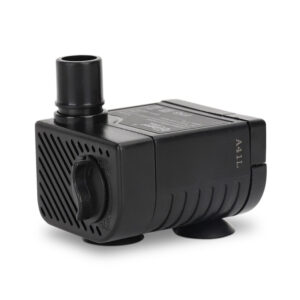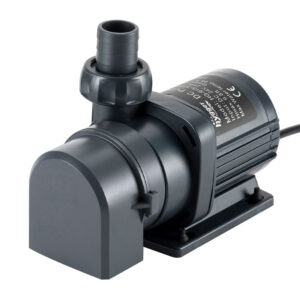By circulating and filtering the aquarium water, the aquarium water pump is vital in maintaining great water quality. In general, there are three types of water pumps for you to choose from, submersible water pumps, in-line water pumps, and DC water pumps. Be on the horns of a dilemma? Take it easy, man. Today’s goal is that by the end of this article, you will have a better idea of how to choose a water pump for aquariums. So, without further ado, let’s get started.
Content Table
How to choose water pumps for aquariums
Generally, diverse aquarium types require different water pumps. For instance, a small water pump is an excellent alternative for a saltwater aquarium, which needs a higher water flow rate. Specifically, the capacity and size of the water pump depend on the size of the aquarium, the density of fish, plants, and other creatures, as well as the filtration system.
Usually, it is best to circulate the aquarium water 7–10 times each hour. As a result, you should know the aquarium size, then you can learn the water volume. Besides that, the more fish, the more feces and waste they produce. Consequently, a fish tank with high density needs an aquarium water pump with a large water flow rate to maintain clean water. Also, the higher the fish density, the larger the water pump power. In addition, provided that there is a greatly powerful filter in your tank, it is feasible to only add a water pump with a lower flow rate.

Choose the best water pump for your aquarium
After knowing how to choose a water pump, then how can you pick the best one for your aquarium? You should see the aquarium size and the GPH of a water pump in advance. Generally, the flow rate of a water pump should be 3–5 times higher than the volume of the tank. Next, we will give you some examples.
As for a 20-gallon fish tank, it is around 75L. And the water flow rate of the water pump should be 60-100 GPH. Accordingly, the electric water pump 18W is a great option, since its water flow rate is 200GPH and you can adjust the water flow according to the tank’s needs. Also, take a 50-gallon fish tank as an example, it is approximately equal to 190L. And the water flow rate should be 150-250 GPH. In this case, a 40W water pump is an excellent alternative, because its water flow rate reaches 400GPH. It’s important that to reserve the excess water flow rate for your tank.
How do you check a water pump?
Water pump maintenance should be an essential part of tank maintenance. So, do you know how to check a water pump? If you know little about that, this segment will give you some ideas.
First of all, you should check the placement. You should keep the water pump far away from the substrate. Otherwise, the sand or gravel entering the pump may cause a clogged water pump or even decrease its lifespan. Moreover, the wire and sucker also need your attention. Since the wire and sucker are soaked in the water, hence, they may be eroded or damaged. Aside from that, you should check whether there are obstructions on the water inlet and outlet, or the pipes. By the way, a high-pitched whining sound or a smell of steam are symptoms of a bad water pump.

How to do in an emergency if the water pump is broken
Facing a damaged water pump, what can you do to decrease the risk of fish death?
If the water pump fails to repair, you can change the aquarium water in an emergency because stagnant water will lead to the death of nitrifying bacteria and pose threats to fish health. The most important thing is to ensure the water quality and the oxygenation in the tank after the water pump is broken.
First, check the bottom of the tank for debris and dead fish, pump out the bottom water, and do a water change immediately. The electric vacuum can help to do the work completely and quickly. You can pump out about 1/3 of the water first. If there is a little range of turbidity in the tank bottom, you only need to properly change the 1/3 water or less, if the creatures have a substantial lack of oxygen, you can change half of the water, and remember to change the bottom water mainly.
Second, adjust the oxygen pump and the filter pump to the max, and change the mechanical sponge, activated carbon, bioceramic balls, etc.
Below are some examples and remedies.
| Examples | Remedies |
| The impeller or other components are entangled with debris or other objects | Clean the impeller or other components with a toothbrush, and rinse them |
| The water inlet or outlet is clogged | Clean the water inlet or outlet |
| The water pump turns off automatically because of water shortage (lower water level) | Restart the water pump |
| The water pump is broken | Repair it or change a new one |
Reminder
After getting the ideal water pump, you should take notice to install and maintain it. For water pump installation, just follow the instructions of your pump. Additionally, to avoid a clogged water pump, you should clean it once a month. Just turn off your pump and clean the hard-to-remove debris with a toothbrush. And carefully clean the small components inside, which may be clogged with debris. Additionally, in the case of calcium in your pump, it is feasible to soak the pump with muriatic acid and citric acid. After that, just rinse and dry the pump.
That is all for today. For more additional ideas about how to choose an ideal aquarium water pump, please feel free to share with us in the comment. We’re happy to receive your sharing. Finally, thanks for your reading.


Leave a comment